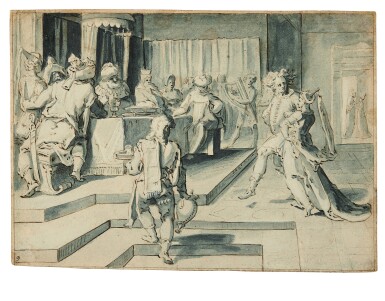
Karel van Mander the Elder
The Dance of Salome
Auction Closed
January 27, 05:29 PM GMT
Estimate
15,000 - 20,000 USD
Lot Details
Description
Attributed to Karel van Mander the Elder
Meulebeke near Courtrai 1548 - 1606 Amsterdam
The Dance of Salome
Pen and dark brown ink and blue-gray wash, heightened with white, within dark brown ink framing lines;
numbered, lower left: 9
175 by 251 mm; 6 ⅞ by 9 ⅞ in
A drawing corresponding in composition to this is in the Schlossmuseum, Weimar, one of a set of nine drawings in the same technique, some of which, like the present work, relate to the story of St. John the Baptist.1 Though long associated with the name of Karel van Mander, those drawings seem to be of a quality inconsistent with what we know of this powerful and dynamic artist, and must surely be copies.
This energetic and stylish drawing, on the other hand, shows a command of line and wash and a sensitivity of lighting that is comparable with many of the artist's designs for prints, such as the two Evangelists, in Dresden2, or the fine sheet showing The Conversion of St. Paul, now in the National Gallery of Canada, Ottawa.3 It therefore seems very likely that this previously unknown drawing is the original by Van Mander, from which the drawing in Weimar was copied - the only one of the nine prototypes for the Weimar drawings that has so far come to light.
Van Mander is possibly best known for his extremely important 1604 publication, Het Schilderboeck, which was not only the first published compendium of biographies of Dutch and Flemish artists, but also an important theoretical treatise on painting and technique. He was also an extremely accomplished draughtsman and painter, and with Hendrick Goltzius a central member of the group of highly innovative artists working in Haarlem in the years around 1600.
This would seem to be a rather significant addition to the small corpus of known drawings by Van Mander, and also a particularly appealing depiction of this alluring yet menacing subject, so beloved of the Dutch Mannerists.
1. Weimar, Schlossmuseum, inv. no. KK 4557; H. Miedema (ed.), Karel van Mander, The Lives of the Illustrious Netherlandish and German Painters, 6 vols., Doornspijk 1995, vol. II, no. D25, reproduced
2. Dresden, Kupferstichkabinett, inv. nos. C1962-261 and 262; reproduced M, Leesberg, The New Hollstein, Karel van Mander, Rotterdam 1999, pp. xcv-xcvi, nos. 20-21
3. Leesberg, op. cit., p. xcvii-xcviii, no. 22
